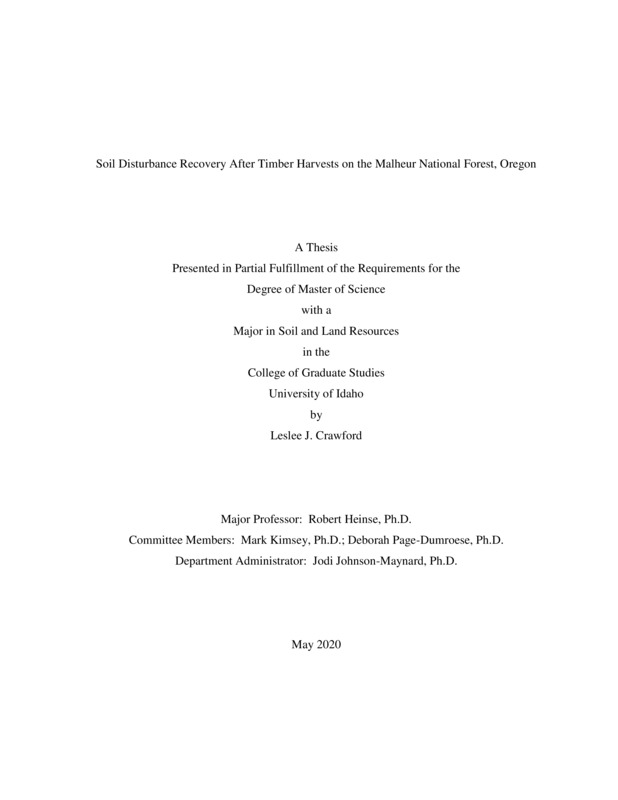Soil Disturbance Recovery After Timber Harvests on the Malheur National Forest, Oregon
Crawford, Leslee. (2020-05). Soil Disturbance Recovery After Timber Harvests on the Malheur National Forest, Oregon. Theses and Dissertations Collection, University of Idaho Library Digital Collections. https://www.lib.uidaho.edu/digital/etd/items/crawford_idaho_0089n_11752.html
- Title:
- Soil Disturbance Recovery After Timber Harvests on the Malheur National Forest, Oregon
- Author:
- Crawford, Leslee
- ORCID:
- 0000-0002-3146-5930
- Date:
- 2020-05
- Keywords:
- Forestry Recovery Soils
- Program:
- Plant, Soil and Entomological Sciences
- Subject Category:
- Soil sciences
- Abstract:
-
Soil productivity is essential to the sustained production of ecosystem goods and services and monitoring the impacts of land management is critical for ensuring the continuation of productive forests. The National Forest Management Act of 1976 (NFMA) mandates monitoring soil property changes following management practices at all national forests, so they “will not produce substantial and permanent impairment of the land”. The Forest Soil Disturbance Monitoring Protocol (FSDMP) was developed by the U.S. Department of Agriculture Forest Service (USFS) to ensure a standard method for collecting pre- and post-harvest soil monitoring data. Data collected following the FSDMP provide temporal and spatial insights into soil recovery rates and alteration of soil processes or hydrologic function following disturbance. The objective of this study was to 1) identify site factors and operational harvest impacts that alter dynamic soil properties, and 2) outline best management practices that account for these site and operational factors.
Prior harvested stands on the Malheur National Forest in northeastern Oregon, USA were identified to reflect a range of soil types, climatic conditions, past timber harvest mechanisms and seasonal timing, as well as topographic position (slope, aspect). Fifty-one stands were selected within a project area approximately 31,000 hectares and monitored retrospectively to evaluate soil disturbance and site characteristics that influence soil recovery from timber harvests completed within the past 5, 10, 20, or 40 years ago.
We found that clay and silt content, spring moisture deficit, fall mean maximum temperature as well as interactions between clay x silt content, depth to restrictive layer x coarse fragment content, and silt x depth to restrictive layer had the most influence on soil disturbance. Important management considerations are (1) harvest operations that occurred during winter months resulted in less soil disturbance, (2) greater clay content (relative to silt content) decreased the amount of soil disturbance, and (3) soils show a trend toward recovery 10-years after harvest operations are complete.
- Description:
- masters, M.S., Plant, Soil and Entomological Sciences -- University of Idaho - College of Graduate Studies, 2020-05
- Major Professor:
- Heinse, Robert
- Committee:
- Kimsey, Mark ; Page-Dumroese, Deborah
- Defense Date:
- 2020-05
- Identifier:
- Crawford_idaho_0089N_11752
- Type:
- Text
- Format Original:
- Format:
- application/pdf
- Rights:
- In Copyright - Educational Use Permitted. For more information, please contact University of Idaho Library Special Collections and Archives Department at libspec@uidaho.edu.
- Standardized Rights:
- http://rightsstatements.org/vocab/InC-EDU/1.0/

